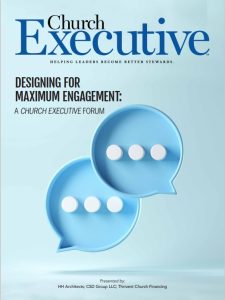

When the term “engaging design” comes up, the financing part of the equation might seem unrelated.
Nothing could be further from the truth.

Senior Relationship Manager
Thrivent Church Financing
I’ve been working in the church loan market, exclusively, for more than 16 years. I’ve known Bruce Woody, President and CEO of HH Architects, that entire time. Our organizations attend and sponsor the same conferences. Outside of learning about projects Bruce is working on, we also see each other multiple times a year at these conferences.
So, sure, there’s a personal relationship; but there’s also a lot of synergy in what we do for church clients — including projects with a truly engaging design, like one we collaborated on near our nation’s capital. Designed like a lodge, it offers large, yet intimate, gathering spaces and a rustic feel throughout. Places where people can gather informally during the week to drink coffee, hit the wi-fi, and socialize.
A facility that doesn’t sleep.
What your space “does to engage” is critical
This project is actually a great reference point for what we’ve found, as lenders, to be the case: affordable and functional design is typically what takes a project from concept to reality.
While “wow” factors can be budget busters, not so for engaging spaces that promote community. In fact, over the past several years, we have seen many more flexible gathering space areas being built as compared to conventional sanctuary space.
Regardless of what kind of space a church is hoping to build, though, affordability is the No. 1 factor. This is why the church, its lender and its architect need to all be in sync early in the process. Only by collaborating can they answer the Big Question: Can the church afford what’s being designed? If phasing the project or scaling it back is necessary, you definitely want to engage the lender and the architect and make sure your plans make sense.
A word about affordability
Let’s talk more about affordability and what that really means.
As your church prepares for expansion, a general rule of thumb is that total project costs should not exceed funds available to pay for those costs. Consider the formula below:
Loan Available + Cash on Hand at Time of Settlement = Total Costs
Whether you are phasing a project or building all at once, lenders can’t underwrite based on future growth expectations. Have a plan, based on what you know today, to fund your project.

As outlined above, lenders generally won’t consider future anticipated events — such as future capital campaign receipts — when underwriting the church for a loan. The church’s strategy of communication for the capital campaign can change based on what your lender outlines as a potential loan.
Simply put, if your church is planning a $10-million project and can borrow $5 million, that means you’ll have to raise $5 million to offset project costs prior to loan settlement. How you communicate with the congregation about the campaign will likely change based on your borrowing capacity.
Don’t shortchange your project with a “business as usual” approach
Completing a successful building project has a lot of moving parts, but the odds greatly increase when the church, lender and architect all work together.
Unfortunately, what often happens is that a church engages the architect first to “draw the dream.” Then, the church contacts the capital campaign firm to raise money for the dream. Then, the church calls the lender … who tells the church that it can’t afford the dream.
Getting a lender to provide a church’s financial capacity on the front end is a game-changer. This way, the ministry can plan based on their financial reality.


